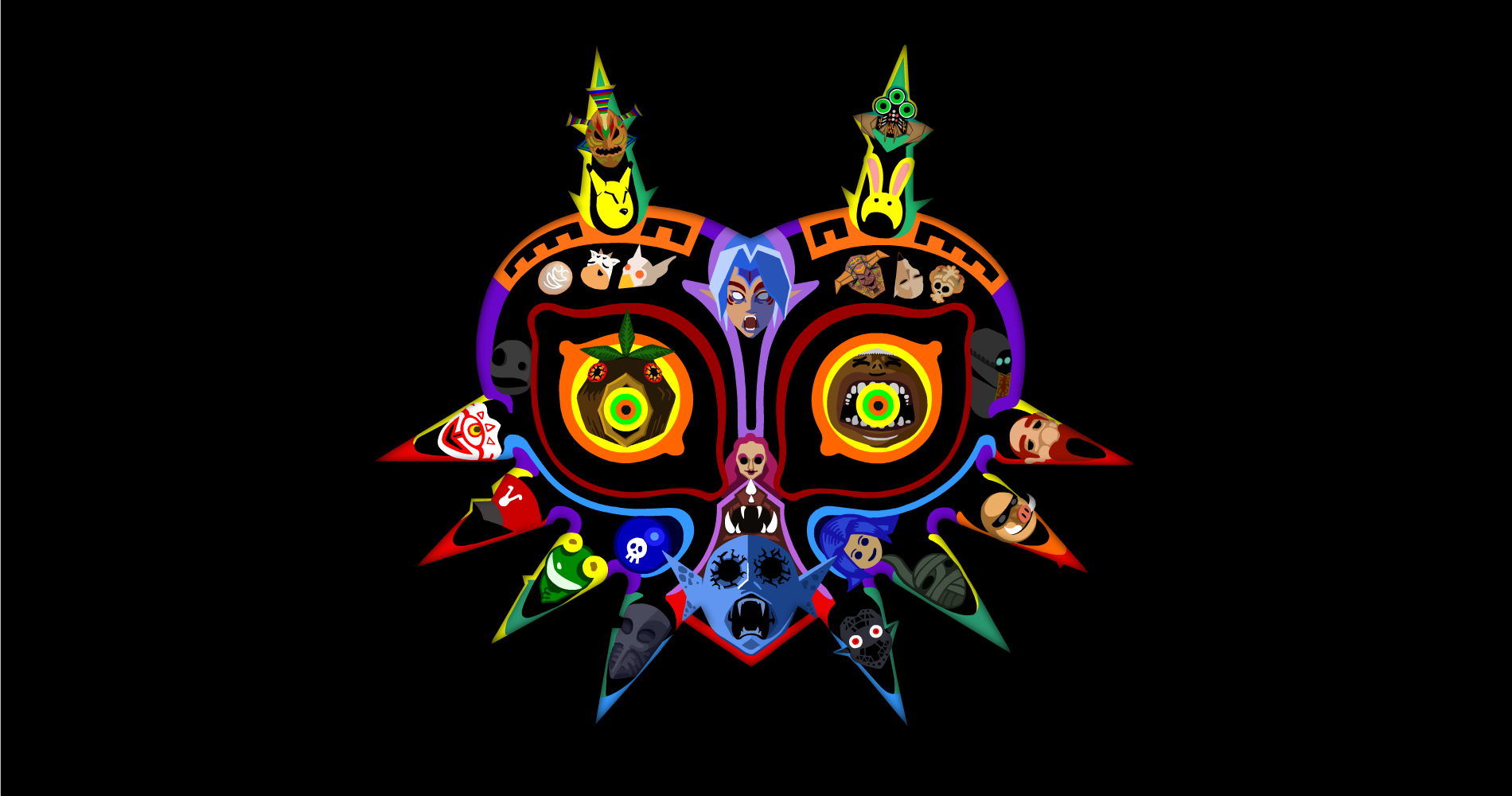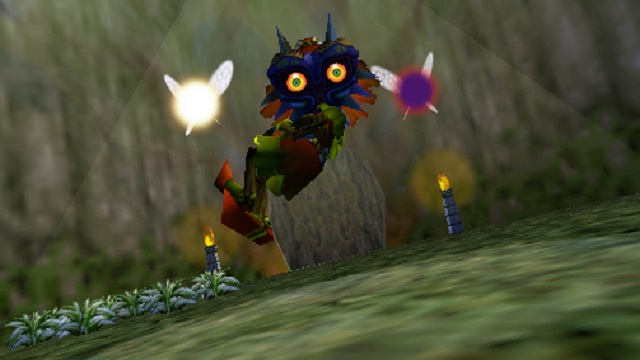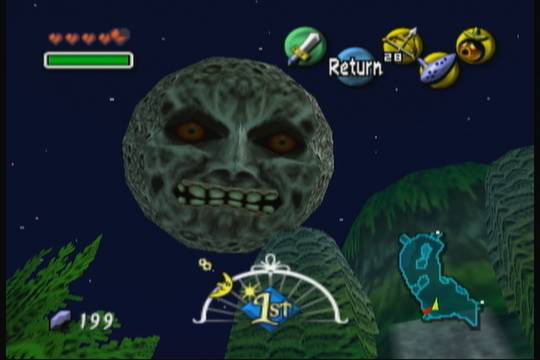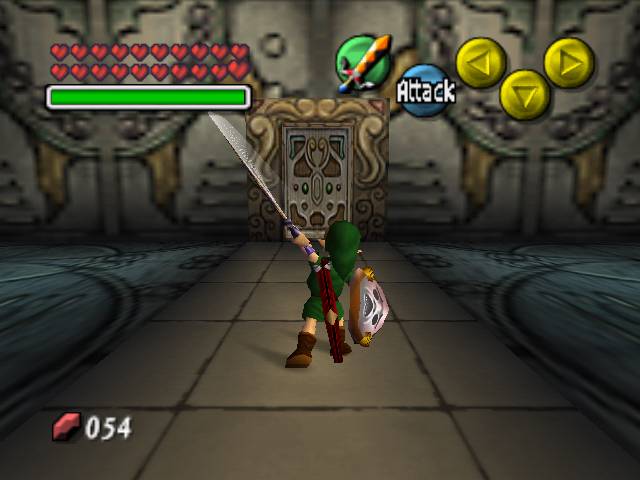Review: Is The Legend of Zelda: Majora’s Mask worth playing now?

The Legend of Zelda: Majora’s Mask launched on the Nintendo 64 at the turn of the millennium, and marked a follow-up to what many still consider the greatest game ever, Ocarina of Time.
Developed in just a year, MM is both similar and starkly different to its predecessor. Sharing many of the same assets, but introducing a radical Groundhog-Day-esque 3 day mechanic, with Link rewinding time and reliving the same 3 days, until the world of Termina is saved from the wrath of the Moon, which is set to crash into the world after the night of the third day.
It’s certainly a unique concept. Frankly, it’s downright bizarre, and a completely unconventional way to follow up something like OoT. But does it work? Does it detract from what made Ocarina so great? Does the time constraint add too much stress? Let’s find out if Majora’s Mask is worth playing now…
Good
Mood: Majora’s Mask oozes atmosphere. The darker colour palette sets the somber theme from the get-go, as Link traverses the Lost Woods and falls into the dimension of Termina. The extra power from the N64’s Expansion pack is put to good use in MM, with the game boasting more fidelity and detail than OoT. The lighting and art direction are more complex, and serve to paint a powerful picture of a bleak, beautiful and warped world.
So much to do: Initially MM feels smaller than most other Zelda games. In keeping with the game’s core theme of inversion, the traditional concept of the hub world is flipped – in place of a central Hyrule field with scattered areas and towns around it, in MM the main hub is the town, with a slim Hyrule field spread around it. The central Clock Town has a simple layout, with North, West South and East segments, but its intricacies, nooks and crannies take time to unravel and discover. As you progress, you’ll realise this was one of the biggest games ever made at the time, both in actual size – the areas you eventually reach on the outskirts of Termina are huge – and primarily in the amount of things you can do.

Every aspect of Majora’s Mask is utilised in some meaningful way. There is no fat in this game. No window dressing. Every character either has their own story that serves as a questline over the course of the three days, or is part of another (or multiple) stories. As you peel back the layers of these narratives as you play, at times it feels like they won’t ever end. It’s the three day mechanic that allows for this impressive depth in the questlines. Every character is essentially on a path during the cycle, and how you disrupt and interact with these paths determines how you do in the quests. You’ll have to observe how characters move, try speaking with them at different times, wearing different masks or giving them different items, and everything makes sense logically so it can be figured out with some thought. It’s compelling and there’s still nothing really like it.
These quests can vary from simple to complex, but the time mechanic allows them to have layers that in previous games wouldn’t be possible. For instance, stopping a mugger from robbing an old lady on the first night will give you a reward form the old woman. Simple enough. But if you hadn’t stopped the woman, the mugger would take his stolen bomb bag to the shady Curiosity Shop, who would then sell the bag later to you for a crazy price. Still nothing OoT couldn’t do here, right? But if you stop the mugging, not only do you get the Bomber’s Mask reward, but if you visit the Curiosity Shop later, instead of the bomb bag in the mugging timeline, he’ll sell you a new Mask. This alternate timeline split just wouldn’t be possible in other games. And this is the most simple example. Kafei’s Quest requires you to figure out multiple things over the three day cycle -delivering letters, stealing hotel rooms and raiding hideouts. It’s an intense experience and one of the most memorable moments in a Zelda game.
Rogue Like: The real kicker is, the examples above are all essentially optional side quests. MM is in essence a rogue-like, with each three day cycle representing a new ‘run’, but with your increased knowledge and key items picked up in previous runs enhancing your ability in the next one. The time loop mechanic again allows for this, and incidentally makes MM the only game in the series where it makes sense that Link would canonically spend serious time on side quests and mini games. Just like Bill Murray’s character in Groundhog Day, why not spend your time trying to get the high score in the archery game? You’ve got infinite time – saving the world can wait! Unlike other games where for every Korok seed you collect or fishing hole you visit, the kidnapped Zelda spends another five minutes trapped in agony.
Bomber’s Handbook: A neat inclusion to the game is the Bomber’s Handbook. You’re given this in your first three-day cycle, allowing you to keep track of the schedule of every character you meet, indicating when you need to interact with them to gain their reward and ‘complete’ their respective quest. It’s great as it doesn’t tell you too much – it doesn’t tell you what you have to do with each character – but serves as a nice indication whether or not you should spend more time with a person.
Difficulty: The designers clearly assumed most players will have played Ocarina of Time before playing MM. The start of the game is essentially as difficult as the end of OoT, with the first dungeon being just as tough as anything in its predecessor. There are genuinely very challenging parts to MM, with certain sections like the Deku Butler race designed to take the average player multiple attempts to get right. There’s nothing that feels unfair, just a welcome challenge in a series that often lacks difficulty.
Hey, Listen: As with OoT, the music and sound design of MM is second to none. The music is catchy but also serves to enhance the melancholy, twisted atmosphere of the game. Tunes like the Astral Observatory, the Clock Town Final Day, and the return of the classic Hyrule Field song will live in your mind as earworms for days, and the recycled sound effects of Link and the other characters and enemies are still as effective here as they were in OoT.
Characters: The inhabitants of Clock Town are more memorable than any cast in any game I’ve played. Yes, their models are recycled assets from OoT, but here the developers have a full three day cycle to flesh them out, whereas in OoT you essentially get two modes – day and night, and most of the time they’re standing still in either of those modes. In MM, you’ll get to know inn keepers, lovers, ranch owners, a mayor and his wife, a postman – all as they go about their busy schedule, all under the impending plight of the ever-encroaching Moon hanging over them, which adds an edge to their personalities and makes them more likely to open themselves up to you in their distress.
Masks: Over the course of your adventure you’ll collect up to 24 masks, each of which possesses its own power, allowing Link to do something new. Some of these will be single-use Masks used in one very niche scenario in the game – take the All-Night Mask, which exists only to keep you awake during an old woman’s long story. But most have more useful and varied uses. The Blast Mask allows you to explode things without bombs, the Stone Mask makes you invisible to enemies, and easily my most used, the Bunny Hood, speeds up your running. The masks’ abilities are woven brilliantly into both the main plot and the side-quests, and allow you to mix up the way you approach challenges, and encourage experimentation. Using a mask in an unexpected place and it yielding positive results is a great feeling.
Temples: A criticism at the time of launch was that MM only has four dungeons. For me, this isn’t an issue for two reasons. Firstly, all four are excellent, easily on par with the best OoT has to offer. And secondly, the depth present in the Hub world and Clock Town more than makes up for it, as the best parts of the game come from interacting with the intricacies of the town, rather than pushing blocks around dungeons.
Little touches: There are several subtle quality-of-life improvements in MM, that serve to provide an overall smoother experience than OoT. Link’s jumping off ledges will vary in distance depending on the speed of the approach, and my favourite improvement is a camera-based one: Now when the camera cuts away to reveal a chest or a newly-unlocked door, instead of cutting straight back to Link, it pans out from that chest or door, and tracks over to Link – so it shows you exactly where it was. It’s such a small thing, but fixes a real annoyance in OoT when it wouldn’t be clear where the reveal occurred thanks to the instant camera cut-back.

Controls: The moment-to-moment controls are largely the same as OoT, with minor tweaks mentioned above. There’s a reason modern action games still control the same way, with the Z-targeting and general weight of Link’s movement being close to perfect. The impressive thing about MM is that there are essentially 3 other playable characters via the transformation masks. You’ll spend a lot of the game playing as a Zora, Goron or a Deku Scrub, each of which come with their own moveset, physics and powers. Usually I’m not a fan of games with multiple characters, but these three are done so well, and as you’re able to switch between them on the fly, that they don’t feel like a hassle. The Goron’s rolling is excellent, and the Zora swimming is the blueprint of how 3D third person swimming should be done.
What to do? As with many of the earlier Zelda games, Nintendo strike an exquisite balance between leaving the player to figure out what to do, and offering subtle guidance so the player doesn’t become completely stuck. Figuring out how to solve a heart piece secret or how to use a mask or weapon is left up to you, with small hints provided by the townspeople, or the Sheika Stones scattered throughout the world. Tatl, Link’s fairy, is also far less intrusive and handholdy than Navi in OoT. Everything allows for players to decide themselves whether they’d like a hint, akin to the hint houses in Link’s Awakening, rather than force unnecessary handholding onto the player, like in the infamous Skyward Sword.
Endgame content: In most Zelda games, after defeating the dungeons and final boss, most of the endgame involves just hoovering up additional Heart Pieces or bottles. Those two are still here in MM, but never has a Zelda game had so much excellent, missable content, as you could feasibly ‘finish’ the game with half of the masks available. Making so much of the content potentially missable by so many player was a brave move by Nintendo, but it pays off as it lends a real sense of mystery and depth to the game. Seeing those empty mask slots creates an itch for players to continue exploring and discovering, as you never know what a new mask’s power will bring. This is much more compelling than pondering whether you need a 24th heart slot.
Mixed
Saving statues: There are a couple of ways to save your progress, and it’s all a bit convoluted. The main way is by going back in time to the dawn of the first day – simple. Nice and easy. But what if you’re mid-quest and have to turn off your machine? Enter the Owl Statues. The serve as handy warp points, but also as a strange temporary-save station. You can only use them once – that is, you save, turn off your machine, go again, and you’re OK – but if you turn off your machine a second time, you’ll be reverted back to the dawn of the first day. Does it make sense? Sort of. Is it confusing? Yes.
Epona: Your beloved horse is back, in pony form. Epona is employed to win a couple of races and act as a progress unlocker as she lets you jump over some barriers that initially block your progression before you get her. Other than that, she’s rather surplus to requirements, as none of the areas in which you can use her are all that big, and using the Bunny Hood or Goron rolling is easier and faster. It’s a shame, as riding Epona was a fundamental joy in OoT. She has her moments in MM, but feels like a tacked on fan service component.
First three days: It’s easy to see why so many people get put off by finishing MM, or claim it’s too difficult. During the first three-day cycle, you spend your time entirely as the Deku Scrub and have to do a fair bit of scavenging and waiting around. It serves as a neat way to get players used to the cycle and familiarise themselves with Clock Town, but it is rather tedious, and is a stark change of pace for someone coming straight off the back of finishing OoT.
Waiting: As much as people like to complain about the time limit being a burden, I’d argue it actually has the opposite effect, as the it actually forces you to wait around a lot more than you would in another game not designed around the flow time. Often you’ll rely on a character reaching a point at a certain time on a certain day, and whilst you learn songs that let you skip large chunks of time, most of the time you’re forced to wait for several hours due to the precision of the timing required. I actually don’t mind this – downtime in games feels rarer these days, and in MM it allows you to explore elsewhere or play around with masks whilst you wait for several hours. Clock Town is so densely packed with things to see and do, and because a different thing will be happening oat any given time of day, that there’s always things to do while you wait.

Linearity: It’s impressive how MM manages to fit an ongoing quest around an ever-resetting world. Four dungeons need to be completed, but because the entire world is exactly the same after every reset, how do you design it in such a way that the player can only get to the third dungeon after beating the second? With a combination of clever gating behind items and songs that you retain with every cycle – and it’s impressive when you see it all unfold. What I would have loved was for the non-linearity of the game’s theme to be more fully reflected in the quest narrative. If they’d made it so you could tackle any of the dungeons in any order, perhaps making them easier depending on how many items you’d collected, then this would’ve been even better. But as it is, it is brilliant, and there are definitely aspects of non-linearity in the side quests and mask collection.
Bosses: The bosses of the dungeons are a real mixed bag in terms of enjoyability. The first, Odolwa, is a brilliantly varied affair, with multiple ways to take him down – and he has many weapons of his own. The second, Goht, is a fun and frantic race around a track with a mechanical bull. But the third, Gyorg, is dreadful – a fish that’s as tedious as it is frustrating to fight. And finally there’s Twinmold, who looks impressive but is insultingly easy. The mini-bosses also vary, as whilst they’re mostly fun, several are repeated throughout each dungeon, which feels a bit lazy.
Bad
Under the Well: Playing trough MM is a 95% brilliant cocktail of discovery, action, charm and emotion. And it’s 5% down the well. This is a tedious section with essentially no challenge, in which all you do is fetch zombies what they ask for from elsewhere in the world. It grinds the experience down to a crawl, and may make players give up, right before the final dungeon. Making this an optional oddity would’ve been better, but it’s an integral part of the game.
Item swapping: A cumbersome feature of the N64 games that’s since been streamlined in recent entries is the item swapping system. Only ever able to hold three items at a time, having to pause the game to switch them, you’ll be constantly hammering the start button to re-equip weapons and masks, and it does disrupt the flow. Throw 24 masks into the mix alongside your weapons and it makes for a frankly unreasonable amount of pausing. Some kind of mask-exclusive mapping to three other slots would’ve been a good move.
Zora eggs: I’ve mentioned the down the well tedium, but there’s also a section in which you have to stealthily gather a bunch of eggs. Stealth sections have never been Zelda games’ forte, with very basic enemy detection mechanics, but what’s annoying about this section is once you’ve gathered the 4 eggs from the pirate gang…there are 3 more eggs you need to nab from a bunch of underwater eels. On a totally different part of the map. This is not just annoying because it feels like pointless padding, but because you’re on that 3-day time limit, it can be a bit of a push to get it all done in time. It’s the only part of the game that doesn’t feel crafted with the three day limit in mind. This and the well section aren’t terrible, but stick out because the rest of the game is so finely tuned.
Inconsistent rewards: A small one, but something I found jarring was how inconsistent the value of rewards for quests felt. Or rather, they’re too consistent – it’s gonna be a mask, a larger bomb or arrow bag… or a heart piece. Almost always a heart piece. What feels odd is that some heart piece quests take a lot to unlock, with quests spanning days featuring lots of characters and timing. And others, you just fall down a hole and kill two lizards. All in all, some more care could’ve gone into some of the rewards, with perhaps another tier of reward for the more complex side quests that don’t result in a mask..
Overall
Not only was Majora’s Mask the best game in the Zelda franchise when it released, but it still is today. It’s one of the few N64 games that doesn’t show its age, and retains all of its mystique, charm and ingenious design mechanics that largely remain unique to the videogame landscape even today. I wouldn’t recommend it as your first 3D Zelda due to its challenge, but once you’ve cut your teeth on one of the others, get to this as soon as possible. It’s absolutely worth playing. Unforgettable. 10/10